HISTORY 135F
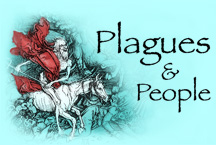
Infectious and
Epidemic Disease in History
Department of History
University of California, Irvine
Instructor: Dr. Barbara J. Becker
HISTORY 135F

Infectious and
Epidemic Disease in History
Department of History
University of California, Irvine
Instructor: Dr. Barbara J. Becker
Cholera's clinical features:

Dehydrated cholera victim
|
Cholera was unknown in Europe until the late 1820s Its home was India--and remained confined there until Europeans, particularly the British, increased their routine contact with the subcontinent. |
|
|
Vasco da Gama (1460-1524) reaches Calicut.
Portuguese establish trading ports along India's western coast. |
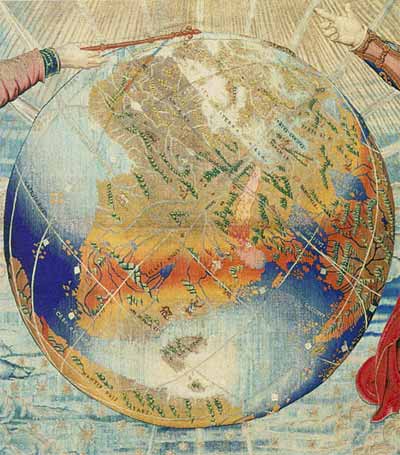
|
|
|
|
British East India Company is formed.
British establish trading posts and forts in Bombay, Madras, and Calcutta. French establish trading site in Pondicherry (India's
southeast coast).
|
|
|
Death of Emperor Aurangzeb ends period of strong
Mogul rule.
|
|
|
British East India Company competes with other
European traders for control.
|
|
|
British East India Company becomes leading power in India. |
|
|
First Cholera Pandemic (1817-1823)
Marquess of Hastings launches military campaign against the Maratha
|

|
|
|
|
Second Cholera Pandemic (1826-1837)
Trade fairs in major cities help cholera spread from India to Afghanistan to Persia to Russia. |
|
|
Russian troops introduce cholera into Poland. |
|
|
Cholera reaches England by ship from Hamburg. |
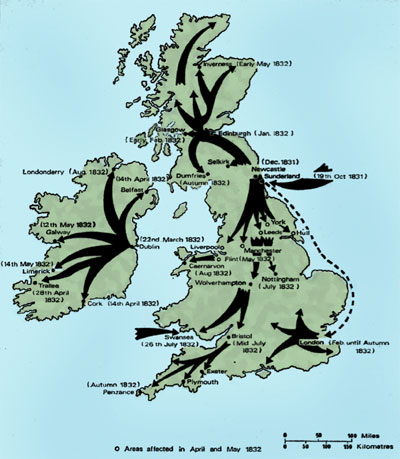 |
|
|
|
Cholera reaches Paris. |
|
|
Irish immigrants carry cholera to Quebec.
Cholera arrives in the US. |
|
|
Cholera reaches Illinois and New Orleans. |
|
|
Cholera reaches the Pacific coast and enters Mexico |
|
|
Third Cholera Pandemic (1841-1859) |
|
|
Cholera reaches England and crosses the Atlantic to Canada and the US (via New York and New Orleans). |
| Cholera travels with 'Forty-niners and other pioneers to the Pacific coast and into Mexico. | |
|
|
|
|
|
Cholera reaches the East Indies, China, Japan, Korea, and North Africa |
|
|
Outbreak in London neighborhood near Golden Square: over 500 deaths in ten days. Attracts the attention of physician, John Snow. |
|
|
Cholera hits Central America |
|
|
Fourth Cholera Pandemic (1863-1875)
geographically, the most widespread pandemic |
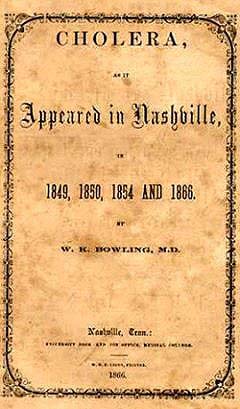
|
|
|
|
Fifth Cholera Pandemic (1881-1896) |
Robert Koch (third from the right) on a cholera research expedition in Egypt in 1884, one year after he identified V. cholerae, the microbe responsible for cholera. |
|
|
|
Sixth Cholera Pandemic (1899-1923)
no impact on western Europe; didn't reach Americas; mostly affected Asia |
|
|
Seventh Cholera Pandemic (1961-) new strain of V. cholerae--El Tor strain; first observed among Indonesian emigres to Egypt in 1905; emerges as pandemic in 1961 |
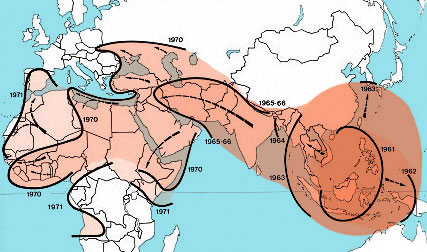 |
|
| Eighth Cholera Pandemic (1991-)
new strain of V. cholerae--Bengal strain; first observed in Bangladesh and India in 1991 |
|
Miasma vs. Contagion:
|
|
1831 The topographical situation of France is so advantageous that there is little to fear in this country from cholera morbus or any other pestilential epidemic. As for the plague's entering by way of our seaports, I find little probability of such an occurrence, particularly in the Atlantic ports, where sanitary measures have been so carefully observed that it would seem to me quite difficult for the disease to infiltrate our borders. And in any event, the disease would quickly be confined to the ports and treated with such success by rational medicine, known to all French physicians, that there need be no fear of its spreading to the interior. Throughout France, the felicitous application that has been made since the Revolution of 1789 of rules of hygiene and health measures has redounded to the benefit of the country's inhabitants.... By contrast, recall that, so far as we know, the disease has proved devastating only in fetid, marshy areas in certain parts of Asia Minor, Russia, and Poland.... Today in no other country of the globe have civilization, industry, and commerce achieved a higher degree of perfection [than in France] and in no country but England are the rules of hygiene more faithfully observed. Cleanliness and above all sobriety, prophylactics against every sort of disease, are the leading traits of the French Citizenry... Enlightenment has spread so widely through all classes of society that everyone is well aware of the precautions to be taken against the causes of disease: We are blessed with a superb and healthy population.... What country, moreover, is richer than ours in enlightened physicians who contribute so powerfully to the maintenance of public health? --Dominique Jean de Larrey (1831) 1832 Should poisoning, pestilence, and death be the watchwords of the government of France, the world's premier nation? ...The admirable people of Paris, who are so heroically confronting the cholera of poverty, which in eighteen months has tripled the death rolls--the people of Paris were not made to serve as fodder for the cholera of Asia and to die like slaves in pain and terror. There is one true protection against cholera; it is to remain, in the presence of this new and ubiquitous enemy, courageous and invincible. There is ... an important lesson to be learned in the midst of public calamity: namely, that man is in part the author of his own destiny. For in the external world man may not always be master, capable of preventing nature from encroaching in ways often destructive to his own work; but he is almost always capable of stopping, and energetically repelling, these invasions of evil, by means of a moral reaction that stems from within.... Paris--that center of civilization and progress, a city where such vast resources are sacrificed on the altar of public welfare--should have demonstrated the power of the social state by triumphing over the most terrible scourge to afflict the human race. Instead, Paris has succumbed to this new invasion; the disease has proved more lethal here than elsewhere; and no quarter of this great city is nowadays so populous as its cemeteries. What good, then, are all its hospitals, its doctors, its science, and its public administration? Are all the resources of civilization worthless? Is civilization incapable of compensating mankind for all the harm it has done through its laws, its institutions, its errors, and its injustices? No: the blame should not be laid at the door of the social state itself. Instead, the finger of accusation should point at those who exploit the state and corrupt it, at those who see civilization merely as a more sophisticated servant of their luxury and pleasure, at those who view a great city as a factory in which all hands labor for their benefit and all space is arranged for their convenience. The city is a city of palaces and hovels: a few splendid quarters with colonnades and huge gardens closed to the man in work clothes and, in the center of this sumptuous enclosure, a sewer of narrow streets and dark, unhealthy buildings, as dank as dungeons, where those who toil come to catch their breath in fetid air.... So, an epidemic arrives, preceded by cries of terror from two continents, and finds its prey ready-made, its victims huddled together and weak. It opens its charnel house in the artisans' district, whereupon the philanthrophists say that the public should take heart, for the scourge seems willing to claim as its victims only the ill-clad, ill-housed, and ill-fed, which is to say, the working people of Paris. --Michel Chevalier (1832) |
Cholera in England |
|
____________________________________ Notes to the Poor on CHOLERA EXPERIENCE having proved that "CHOLERA" is not contagious, let no one fear to render assistance to his Neighbour, or any Fellow-Creature who may be attacked with it. Keep the mind at rest, trusting in God, and "fear not the Pestilence though it walk in darkness, nor the Destruction that wasteth at noon-day." "CHOLERA" in its early stages is easily curable. When more advanced, is not only difficult to cure but almost defying the power of Medicine. Preventive measures and prompt attention to the earliest symptoms are chiefly to be relied upon. The Causes predisposing to "CHOLERA," and therefore to be avoided as much as possible, are--want of Cleanliness of Person,--Intemperance in the use of Spirits--of fermented Liquors--or of Tobacco,--Debauchery, or excess of any kind,--Irregular Habits,--excessive Fatigue,--Sitting in wet Clothes,--or indeed exposure either to wet--cold--damp--or sudden Chills. The great preventive of "CHOLERA," is--Pure Air and Cleanliness. Every House ought therefore to be kept perfectly clean and thoroughly ventilated. Lime-washing is particularly recommended, and persons whose Work is out of doors should wear a flannel belt round the body, next to the skin. The symptoms of "CHOLERA," which should act as a warning, are--Looseness of the Bowels or Diarrhoea--Nausea or Sickness--in which stage it is easily curable or preventible. If neglected, the Blue Stage or "ASIATIC CHOLERA" comes on, in which little help is derivable from Medicine. Let none therefore neglect the slightest signs of Looseness or Diarrhoea, or any other irregularity in the system, as there is a tendency, during the prevalence of "CHOLERA," for all Diseases to merge into this Complaint. The Guardians are prepared to issue "CERTIFICATES" to the Poor generally, entitling them to Medical Relief gratuitously, should "CHOLERA" break out, or its symptoms prevail in the Neighbourhood. They recommend such persons as cannot afford to pay for Medical attendance to apply forthwith to the Relieving Officer, who will lay the application before the Board. It is important for the Poor to be put in possession of these "CERTIFICATES" before they are actually required. BOARD ROOM, LEYTONSTONE,By order of the Board, 29th September, 1848. |
Edwin Chadwick (1800-1890)
|
 |
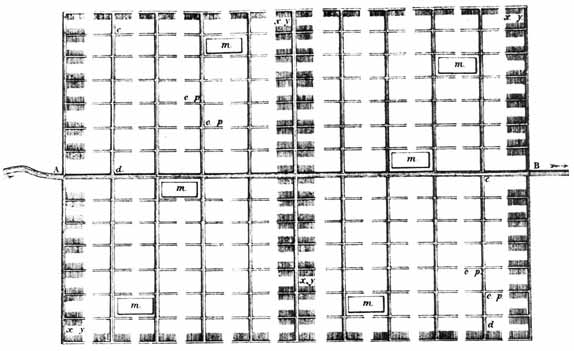
Chadwick's sanitary sewer plan |
|
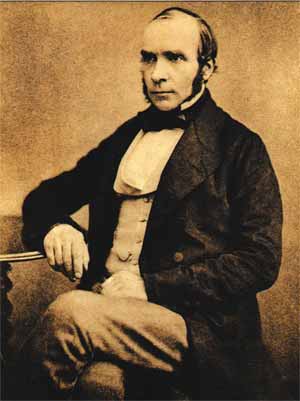 |
John Snow (1813-1858)
|
Edmund Cooper, an engineer for the Metropolitan
Commission of Sewers, also studied the outbreak of cholera in the vicinity
of Broad Street. His investigation was prompted by public fears that
recent sewer line construction in the area had disturbed old plague pits
thereby releasing harmful material into the air. Some residents worried
that the gully holes, through which sewer gases were vented to the surface,
were especially dangerous sources of cholera.
On September 26, 1854, the Commission held a special public meeting to address these concerns. According to The Times of London: "Mr Cooper had prepared a plan which accompanied his report, and on the plan a distinguishing mark was affixed, showing the houses in which death had occurred." Cooper's "plan" was the first so-called "spot" map made to show the geographical distribution of cholera deaths in the neighborhood. In December, John Snow created a similar spot map to illustrate his own views on the cause of the severity of the outbreak in Golden Square.
John Snow's "spot map" showing cholera deaths in the Broad Street area. After analyzing his map, Edmund Cooper drew the following conclusions:
|
||
Cholera epidemics struck Europe in a period of economic growth, material progress and scientific achievement. Affected the healthy as well as old and infirm. TB killed more people, but cholera killed swiftly and horribly. Was the psychological and social impact of cholera powerful enough to override the fact that--in terms of the absolute numbers of people affected--its impact was relatively minor compared to that of tuberculosis or various forms of infant mortality?Traveled at the speed of moving people. What role did advances in transportation technology play in the spread of cholera?Did not strike rich and poor in equal measure. Did cholera epidemics play a part in fomenting the political upheavals of the nineteenth century? Who or what did people blame? How was state policy affected? |
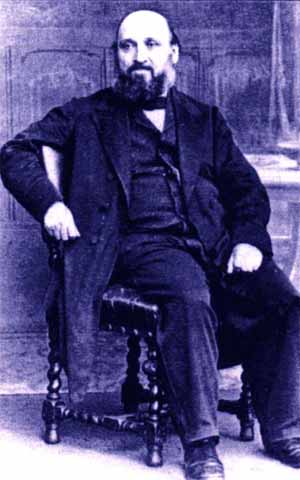 |
by Dr. William Farr (1807-1883)
*Based on data gathered during the 1848-1849 epidemic in London |
||||||||||||||||||||||||||||||
Cholera in Germany |
Hamburg, Germany is situated on the Elbe River where it enters the Baltic Sea. In 1892, it was a self-governing city-state embedded in the Reich of the new kaiser, Wilhelm II, and one of the principal points of departure for millions of Europeans on their way to new lives in the New World. Hamburg provided few public services to its citizens, relying instead on private investors to supply what was needed and people were willing to purchase. Hamburg's water came directly from the Elbe River. By that time, water filtration was recognized as an effective deterrent to the spread of cholera. Reich-ruled cities like Berlin had long since taken steps to make filtered water available to their residents. Even Altona, a small town immediately downstream from Hamburg, and which also took its water from the Elbe, had its own public filtered water system. Unfortunately, the high cost of installing and maintaining such a system had delayed Hamburg's plans for twenty years. |

| In August 1892, a trainload of hopeful emigrés arrived in Hamburg. Before they could depart for America, the travelers were held in quarantine in a special facility near the dock. |

| The passengers were subjected to medical inspection. |
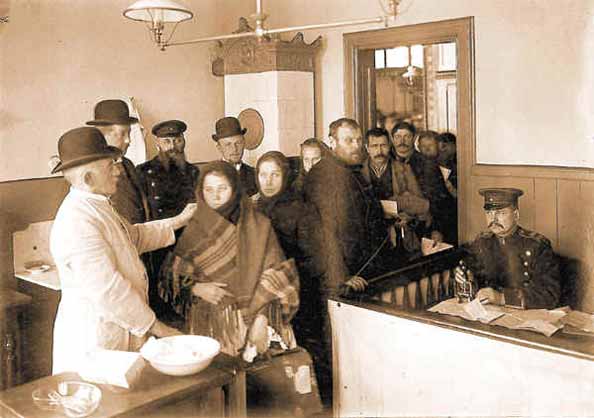
| Some of the new arrivals were infected with cholera. |
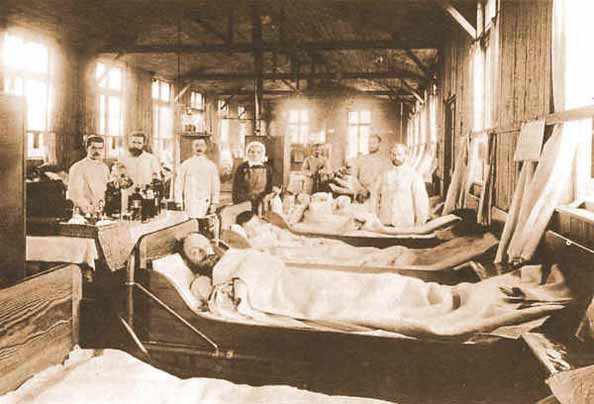
That year Hamburg paid a high price for its lack of
a water filtration system.
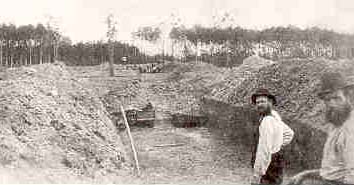
Mass grave for Hamburg's cholera victims, 1892 |
 |
| Go to: |
|
|